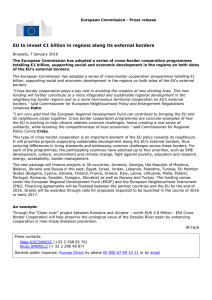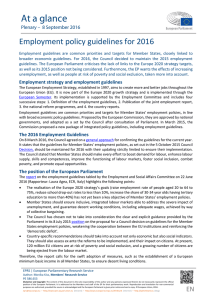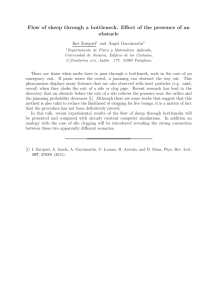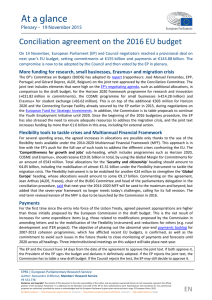Smart Borders: EU Entry/Exit System, EU Legislation in progress
Anuncio
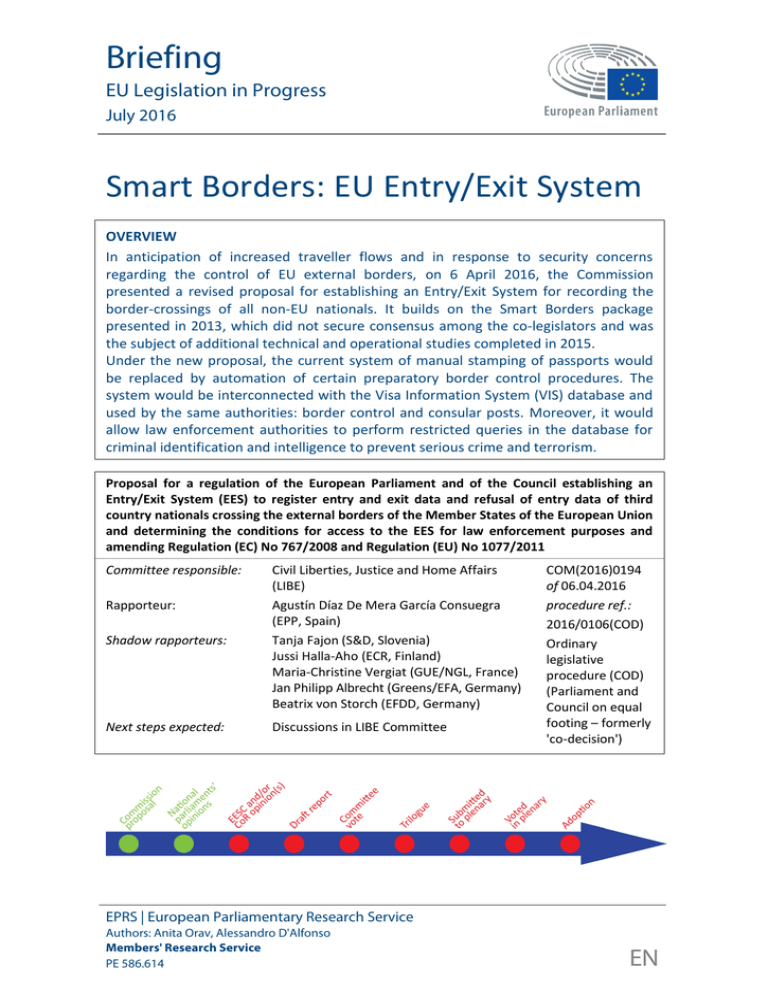
Briefing EU Legislation in Progress July 2016 Smart Borders: EU Entry/Exit System OVERVIEW In anticipation of increased traveller flows and in response to security concerns regarding the control of EU external borders, on 6 April 2016, the Commission presented a revised proposal for establishing an Entry/Exit System for recording the border-crossings of all non-EU nationals. It builds on the Smart Borders package presented in 2013, which did not secure consensus among the co-legislators and was the subject of additional technical and operational studies completed in 2015. Under the new proposal, the current system of manual stamping of passports would be replaced by automation of certain preparatory border control procedures. The system would be interconnected with the Visa Information System (VIS) database and used by the same authorities: border control and consular posts. Moreover, it would allow law enforcement authorities to perform restricted queries in the database for criminal identification and intelligence to prevent serious crime and terrorism. Proposal for a regulation of the European Parliament and of the Council establishing an Entry/Exit System (EES) to register entry and exit data and refusal of entry data of third country nationals crossing the external borders of the Member States of the European Union and determining the conditions for access to the EES for law enforcement purposes and amending Regulation (EC) No 767/2008 and Regulation (EU) No 1077/2011 Committee responsible: Shadow rapporteurs: Civil Liberties, Justice and Home Affairs (LIBE) Agustín Díaz De Mera García Consuegra (EPP, Spain) Tanja Fajon (S&D, Slovenia) Jussi Halla-Aho (ECR, Finland) Maria-Christine Vergiat (GUE/NGL, France) Jan Philipp Albrecht (Greens/EFA, Germany) Beatrix von Storch (EFDD, Germany) Next steps expected: Discussions in LIBE Committee Rapporteur: COM(2016)0194 of 06.04.2016 procedure ref.: 2016/0106(COD) Ordinary legislative procedure (COD) (Parliament and Council on equal footing – formerly 'co-decision') EPRS | European Parliamentary Research Service Authors: Anita Orav, Alessandro D'Alfonso Members' Research Service PE 586.614 EN Smart Borders: EU Entry/Exit system EPRS Introduction In 2015, over 50 million third-country nationals (TCN) visited the European Union, accounting for more than 200 million border crossings. The growth in cross-border travel is expected to continue, which means that Member States will need to adjust the reception capacity of their border management systems. At the same time, the unprecedented migratory flow into the EU reached a new high in 2015, with 1.8 million irregular border crossings reported by Frontex. Border management capacities were exhausted at the main points of irregular entry along the external border of the EU, which enabled the mixed flows of asylum-seekers and migrants to travel onwards within the Schengen area. These developments put strong pressure on the Schengen area of free movement, which is perceived as one of the most recognisable achievements of the EU, and created tensions between Member States. Moreover, increased traveller flows need to be considered in a new security context, due to risks of serious crime and terrorism arising from the threat posed by ISIL/Da'esh, radicalisation and foreign fighters. After the terrorist attacks in Europe in 2015, several gaps were identified in the use of tools for exchanging information between Member States. In line with calls from the European Parliament and the Council, and building on its earlier Smart Borders initiative, on 6 April 2016, the Commission presented a proposal for establishing a new system for registering the entry and exit of non-EU nationals crossing the external borders of the Member States. The proposal is now being discussed by the co-legislators. The Commission hopes for adoption of the proposal by the end of 2016, and for the Entry/Exit System to become operational by 2020. Existing situation In the field of border management, the EU has developed three centralised information systems that address different objectives: the Schengen Information System (SIS); the Visa Information System (VIS); and Eurodac. While VIS and Eurodac focus on thirdcountry nationals and have law enforcement as an ancillary objective, SIS is also relevant to EU nationals and directly supports both external border control and law enforcement cooperation. Table 1 – Centralised border management systems in the EU Schengen Information System (SIS) Visa Information System (VIS) Eurodac SIS is a large-scale information system that enables lawenforcement authorities, such as police and border guards to enter and consult alerts on suspected criminals, people who may not be entitled to enter into or stay in the EU, on missing persons and on stolen or lost property. VIS is used at all Schengen external border crossing points and in consulates outside the EU to exchange and process visa applications and decisions, also through means of biometric matching, based on fingerprints for identification and verification. Eurodac is a biometric database in which Member States are required to enter the fingerprint data of irregular migrants or asylumseekers to identify where they entered the EU, and thus determine the Member State responsible for examining their asylum application. Source: European Commission, DG HOME Members' Research Service Page 2 of 8 EPRS Smart Borders: EU Entry/Exit system In addition to the three central systems developed by the EU, a number of other information systems related to border management and/or law enforcement are available in the EU, each with particular institutional, legal and policy contexts. Examples are Interpol's Stolen and Lost Travel Documents database, Advance Passenger Information (information on passengers ahead of inbound flights to the EU) and the European Criminal Records Information System (ECRIS). While the existing information systems for border controls and/or law enforcement cooperation cover a wide range of data and functionalities, this complex landscape includes some shortcomings: different governance systems; information gaps; fragmentation; limited interoperability and possible inconsistency between databases. One information gap identified by the European Commission concerns the systematic recording of external border crossings movements of all third-country nationals visiting the Schengen area for a short stay (maximum 90-day period in any period of 180 days) and the related tracking of the time spent within the area. At present, the only means that relevant authorities have to calculate the duration of stay of a third-country national in the Schengen area and to verify their potential overstay, is the stamping of their travel document with the dates of entry and exit. This method is deemed to be slow and error-prone, since the entry/exit stamps may be unreadable or counterfeit. According to the Commission, this information gap may have a negative impact on a number of fields, including: the quality and speed of border controls involving third country nationals; the systematic and reliable monitoring of third-country nationals' authorised stay within the Schengen area; and the possibility to identify third-country nationals who have destroyed their official documentation after entering the Schengen area. With a view to addressing these shortcomings, the European Commission has put forward a revised proposal to establish an Entry/Exit System (EES), a new centralised information system based on biometrics that would be interconnected with VIS and focus on third-country nationals. Comparative elements In February 2013, the Commission reported that 13 EU Member States (Bulgaria, Cyprus, Estonia, Finland, Hungary, Latvia, Lithuania, Malta, Poland, Portugal, Romania, Slovakia and Spain) were implementing national Entry/Exit systems collecting relevant records of third-country nationals crossing their respective external borders. However, these systems cannot provide data on travel flow and movement of third-country nationals across the external borders of the Schengen area, since they are not linked to similar systems in other Member States. For example, a third-country national entering the area in a Member State using such a national system may exit from a different Member State, which results in the impossibility of matching entry and exit records. Parliament's starting position Parliament's Committee on Civil Liberties, Justice and Home Affairs (LIBE) had actively worked on the 2013 proposal for the establishment of an EES, prompting a debate that contributed to the 2016 revision of the proposal. Relevant initiatives include a January 2015 working document by the rapporteur, which identified key issues for consideration, such as: the possibility of granting security forces access to the system; the guarantee of data protection (through the principles of proportionality and need); interoperability with pre-existing national systems, with a view to reducing costs and easing maintenance; and the need to take into account the lessons learnt from the Members' Research Service Page 3 of 8 EPRS Smart Borders: EU Entry/Exit system experience with the development of SIS II. In February 2015, the LIBE Committee organised a meeting on Smart Borders with representatives of national parliaments. On 9 June 2015, a debate on the first version of the Smart Borders Package was held in plenary with the participation of Dimitris Avramopoulos, European Commissioner for Migration, Home Affairs and Citizenship. Preparation of the proposal The first version of the Smart Borders package tabled in 2013 raised a number of contentious issues that were subsequently assessed in a so-called 'proof of concept' exercise to evaluate the technical, organisational and financial impact of possible solutions. The first stage of the exercise consisted of an additional Technical Study (including a new Cost Analysis), completed in October 2014, which explored numerous options in relation to biometrics, border control processes, data, architecture and costs, with a view to identifying a limited number of suitable solutions to be tested in the next phase. The second stage, a one-year pilot project, carried out by the European Agency for the Operational Management of large-scale IT systems (eu-LISA), tested the identified set of technical options against measurable criteria (e.g. accuracy, effectiveness and impact on border-crossing duration), complemented the results with desk research and collected feedback from travellers and border guards. In November 2015, the pilot project final report assessed the feasibility of using biometric identifiers at external Schengen borders positively. The proof of concept exercise, and the consideration of a series of relevant developments which have intervened since the tabling of the initial proposal (e.g. visa liberalisation dialogues; the Court of Justice of the EU judgment on the Data Retention Directive; and EP and Council political agreement on the reform of data protection rules), contributed to the revision of the 2013 package. This has resulted in a revised proposal for the EES and the withdrawal of the proposal to establish a centralised Registered Travellers Programme (RTP). The revised proposal is accompanied by a new impact assessment. Under the 2014-2020 Multiannual Financial Framework (MFF), the financial implications of the EES proposal are covered by the Borders and Visa instrument of the Internal Security Fund (ISF), which earmarks €791 million for the development of IT systems supporting the management of migration flows across EU external borders. The revised EES proposal estimates the budget needed for the new system at €480 million, which would allow reallocation of the remaining €311 million to other ISF measures, as set out in Regulation (EU) No 515/2014. The financial resources the Commission estimates as necessary are down from €1.1 billion in 2013, when the figures covered two systems (EES and RTP) instead only the EES, and a longer timeframe (development and operation between 2015 and 2020 versus 2017-2020 in the new proposal). In addition, modifications included in the new EES proposal have had an impact on the estimated costs of the system – for example to consider the technical options for interoperability with other systems, as well as the higher costs entailed by a longer data retention period. According to the Commission, the design of the proposal takes lessons learnt from past developments of other large-scale IT systems into account, such as the second generation of the Schengen Information System (SIS II), to which the European Court of Auditors devoted its Special Report 3/2014. In particular, the Commission says that the proposal: 1) makes the start of the development conditional on the final adoption of the underlying legal instruments, to avoid incurring possible cost overruns and delays due Members' Research Service Page 4 of 8 EPRS Smart Borders: EU Entry/Exit system to changing system requirements; 2) includes in the €480 million budget the reimbursement of all the integration costs incurred by the Member States, with a view to avoiding possible delays in the developments of the system at national level and to enabling the Commission to monitor the advancement of these developments; and 3) tasks eu-LISA with developing not only the central system but also a common national uniform interface (NUI), so as to facilitate the coordination of the implementation. The changes the proposal would bring The proposal brings out three main objectives: 1) improve the management of external borders; 2) reduce irregular migration, by addressing the phenomenon of overstaying; and 3) contribute to the fight against terrorism and serious crime and ensure a high level of internal security. One of the main changes would be that the manual stamping of passports at border checks would be replaced by registration in a database. The proposal gives Member States the possibility to automate most of the data- and information-capturing steps that are currently undertaken by border guards performing border checks on non-EU nationals. The new system would apply to all TCNs, whether visa-required or visaexempt, thus significantly expanding the EU's biometric information system. To balance the expansion, the set of biometric data would be reduced, compared to the previous proposal (four fingerprints and facial imaging, instead of 10 fingerprints). By using self-service systems and e-gates, TCN travellers would have their data verified, their picture or fingerprint taken and a set of questions asked. Visa-required travellers would also be able to see the maximum length of their authorised stay. While using the self-service system, all mandatory checks would be triggered in the security databases (SIS, Interpol Stolen and Lost Travel Documents database). By the time the traveller is guided towards a border control lane, all this information would have reached the border guard, who may ask additional questions before granting the passenger access to the Schengen area. EES would be used by the same authorities that already use VIS: consular posts and border control. EES and VIS could be interconnected, which would help reduce duplication of data processing, in accordance with the 'privacy by design' principle. The Commission states that EES would fit into the current border management architecture and would be interoperable with existing systems. The automation of the preparatory steps is expected to reduce the workload of border guards. This would mean that that Member States would not have to hire extra border guards to accommodate the growing traveller flows. It is also expected to reduce the long queues before passengers reach the border checkpoint. The Commission notes that the automated preparation phase would free up border guards' time, which could be used more valuably to assess each individual situation, thus contributing to enhanced internal security. In the same vein, another important change is law-enforcement access to the EES, permitting national law enforcement authorities as well as Europol to make queries for criminal identification and criminal intelligence. As expected outcomes, the Commission asserts that EES will support the identification of terrorists, criminals and suspects, but also victims of crime. By providing a record of their travel histories, it would complement the alerts recorded in the SIS. Members' Research Service Page 5 of 8 EPRS Smart Borders: EU Entry/Exit system The accompanying proposal amending the Schengen Borders Code as regards the use of the Entry/Exit System will also provide a harmonised legal basis for the establishment of national Registered Travellers Programmes by Member States on a voluntary basis. This entails pre-vetting frequent travellers in a specific Member State in the Schengen area, to speed-up their border-crossings. A separate proposal for establishing a centralised Registered Travellers' Programme has, however, been withdrawn in the revised Smart Borders Package. Advisory committees The two advisory committees have not yet presented their opinions. The Committee of the Regions will resume working on this dossier in the light of its opinion on the 2013 proposal. Work is under way in the European Economic and Social Committee (EESC), with the Employment, Social Affairs and Citizenship section opinion expected to be adopted at the plenary session of 21-22 September 2016. Work will build on the EESC opinion adopted on the 2013 proposal. The EESC, in its opinion adopted on 10 December 2015 on the European Agenda on Migration, asserted that 'the concept of smart borders is welcome and overdue' but highlighted that it should not violate the human rights of migrants and that it 'must fully respect fundamental rights and freedoms'. National parliaments The deadline for subsidiarity check in national parliaments was 28 June 2016. No reasoned opinions have been issued although several parliaments opened political dialogues. The previous 2013 proposal was not challenged in Member States' parliamentary scrutiny, but political dialogue with the Commission was opened by the Czech Senate and the Romanian Chamber of Deputies, both expressing their support for the proposed instruments. Stakeholders' views The main points raised by the stakeholders1 remain the same as for the 2013 proposals: possible fundamental rights implications and cost efficiency of the system. Data protection The proposed system needs to be assessed from a data protection aspect, since it would lead to fingerprinting all TCNs, thus retaining large amounts of both personal and biometric data. The European Data Protection Supervisor (EDPS) in his 2013 Opinion warned against the risk of violating a person's rights under the EU Charter of Fundamental Rights, particularly rights to respect for private and family life (Article 7) and protection of personal data (Article 8). Commenting on the data protection perspective of the Smart Borders package in November 2015 (prior to the publication of the new proposal), the European Data Protection Supervisor, Giovanni Buttarelli, noted that the new system has to 'achieve apparently contradicting purposes: facilitate mobility while keeping borders safe, with low costs, error-free and fully respecting fundamental rights (dignity and protection of personal data)'. He noted that large-scale collection of personal data always requires significant justification. Members' Research Service Page 6 of 8 EPRS Smart Borders: EU Entry/Exit system As regards law enforcement access, the EDPS noted that requests to access data should always be proportionate, narrowly targeted, and triggered by a suspicion as to a specific person. He agreed with the Dutch Presidency recommendation to apply a preliminary test (the so-called 'Schecke test' established in the CJEU case Volker und Markus Schecke GbR (C-92/09)) to the EES, and concluded that the retention of data for law enforcement purposes would lead to an interference with the fundamental right to privacy, as it would apply to persons for whom there is no evidence suggesting any link with serious crime. Moreover, he referred to the Digital Rights Ireland Ltd (C-293/12) judgment, where the CJEU established that every collection, use and transfer to another authority constitutes a separate interference with fundamental rights. This is relevant for EES because law enforcement authorities would be accessing data originally collected for other purposes (calculating visa duration). This view is largely shared by EDRi, an association of civil and human rights organisations from across Europe. Responding to the public consultation in October 2015, EDRi expressed the view that data collection, as proposed within the Smart Borders initiative, is disproportionate and unnecessary. The Meijers Committee (Standing Committee of Experts on International Immigration, Refugee and Criminal Law) issued a note for the attention of the European Parliament on the 2013 proposal, expressing deep concerns regarding, inter alia, the proportionality and feasibility of the proposals, data protection standards for the data subjects, and possible law enforcement access to EES. It recommended the European Parliament vote against the Smart Borders proposals of 2013. Agency for Fundamental Rights survey on travellers' fundamental rights perceptions The EU Agency for Fundamental Rights (FRA) conducted a survey as part of the tests on the technical elements carried out within the pilot project by eu-LISA. To assess travellers' perception of the proposed measures and their attitudes regarding fundamental rights when using biometrics in border control, FRA interviewed more than 1 200 TCNs at seven land, sea and air border crossing points in 2015. The results presented in the Smart Borders pilot final report revealed that more than half (60%) of the respondents are comfortable with having their fingerprints taken and don't feel that it violates their right to privacy (47%) or dignity (70%). It is, nevertheless, pointed out that one fifth finds this procedure intrusive and humiliating. In addition to believing that errors would be hard to correct in the system and that in case of a system breakdown they would not be able to cross the border, over 80% of respondents insisted on the need for information as to why their personal data is collected and processed. Costs In his opinion on the 2013 proposal, the EDPS raised questions on the cost efficiency of the EES, including its financial aspects. A 2013 study carried out for the EP Civil Liberties Committee criticised the Commission's costing of its initial proposal and recommended carrying out a new costing analysis, which should include the financial implications for the Member States. A 2013 paper published by the CEPS think tank agreed that the Commission estimates in the first proposal were not financially sound. Statewatch also reported criticisms on proposed costs and the broader proposal. The additional Technical Study carried out for the Commission in 2014 included a new Cost Analysis, which led to the revision of the financial implications of the EES in the updated proposal tabled in 2016. Members' Research Service Page 7 of 8 EPRS Smart Borders: EU Entry/Exit system Academic views Assessing the use of smart surveillance technologies in border control, commentators have pointed out that the objective of EES to catch visa over-stayers is not entirely viable, as it will only identify people crossing the external borders and not those staying in the EU irregularly. Concerning the obligation to give personal and biometric information when crossing the border, they observe that refusal to be fingerprinted or having a facial image taken may result in viewing the traveller as a risk. Legislative process The legislative proposal (COM(2016)0194) was presented on 6 April 2016. It falls under the ordinary legislative procedure (2016/0106(COD)). In the European Parliament, the proposal has been assigned to the Civil Liberties, Justice and Home Affairs Committee (LIBE) and is awaiting discussions in committee before the rapporteur issues a draft report. EP supporting analysis - EPRS Initial Appraisal of the Commission Impact Assessment 'The Establishment of an EU Entry/Exit System', May 2016. - EPRS Briefing 'Internal Security Fund (ISF)', April 2016. - EPRS At A Glance note 'Smart Borders Package', June 2015. - Policy Department C: Citizens' Rights and Constitutional Affairs study on 'The Commission's legislative proposals on Smart Borders: their feasibility and costs', October 2013. - Initial appraisal of a European Commission Impact Assessment 'Smart Borders Package: European Commission proposal on the entry/exit data of third-country nationals crossing the external borders of the EU', September 2013. Other sources Entry/Exit System (EES), European Parliament, Legislative Observatory (OEIL). Endnote 1 This section aims to give a sense of the debate on the issues surrounding the legislative file and cannot provide an exhaustive account of all the different views expressed. For an institutional perspective on stakeholder participation, see the section on advisory committees. Additional information can also be found in related briefings listed under 'EP supporting analysis'. Disclaimer and Copyright The content of this document is the sole responsibility of the author and any opinions expressed therein do not necessarily represent the official position of the European Parliament. It is addressed to the Members and staff of the EP for their parliamentary work. Reproduction and translation for noncommercial purposes are authorised, provided the source is acknowledged and the European Parliament is given prior notice and sent a copy. © European Union, 2016. [email protected] http://www.eprs.ep.parl.union.eu (intranet) http://www.europarl.europa.eu/thinktank (internet) http://epthinktank.eu (blog) First edition. The 'EU Legislation in Progress' briefings are updated at key stages throughout the legislative procedure. Members' Research Service Page 8 of 8
